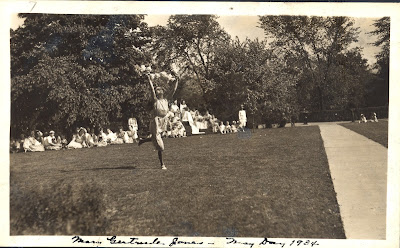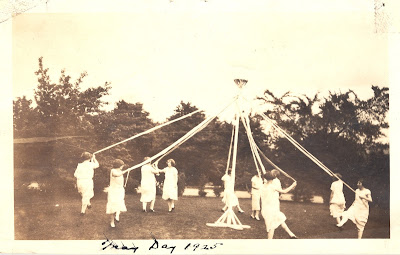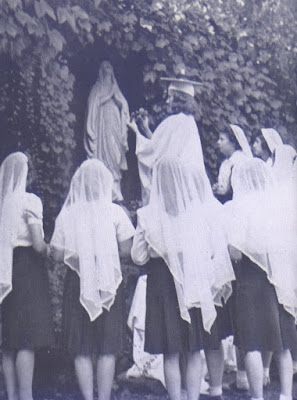These two photos are from May Day 1925. We see the "May Court" with the heralds trumpeting their arrival. You can see that a couple of the girls behind the trumpeters are carrying elaborate baskets, while others have bouquets or armloads of blossoms. In the second photo, we get to see a May Pole; while May Day celebrations have died off in the United States over the decades, many of us probably got to participate in one of these as children.
 |
| King and Queen of May: Grace Boslett, '33, and Barbara Yahner, 32 |
This shot is dated 1932, and here we get to see a few curious trends emerging. First, the "King and Queen of May" are now wearing renaissance costumes instead of the (mostly) contemporary clothing of seven years earlier. Second, yes, the King is named Barbara.
The May Court was chosen in a similar fashion to modern-day Homecoming courts-- by vote-- and the May King was a separate voting category from May Queen. So Barbara and any runners-up for May King were nominated for the May King role.
 |
| Mary Gertrude Jones, May Day 1934 |
You may recognize the location of this 1934 photo. Part of the May Day festivities were a parade to the front lawn (in front of what is now the Administration building). In the background behind the dancer, you can see girls sitting around on the grass, while the court is seated upon a raised dais.
This 1936 May Court features a mixture of 30's and Renaissance clothing. Here, again, we have a female May King, and here, again, the King is taller than the Queen. The rest of the court, other than the heralds, are wearing dresses.

This unnamed student was May Queen in 1937.
And here we have a student crowning Mary with flowers in the Grotto in 1947.
May Day celebrations at Seton Hill, as in much of the rest of the country, began to fade out shortly after World War II. May 1st is also known as International Workers' Day, which was widely observed in communist countries, making it more problematic for many Americans during the Cold War.
For more information about the history of May Day, you can find more on History.com.





I wonder where that garden wall and gate is where the May Queen and King are picture by themselves?
ReplyDelete